
In this article, we will explore the two main methods of preserving fresh breast milk: freeze drying and dehydrating. We will discuss the importance of preserving nutrients in breast milk and compare the benefits of these methods, including exploring the most common preservation method, freezing. Using a breast pump can help mothers express milk for preservation, providing flexibility for breastfeeding, especially when returning to work or needing to store expressed milk. By understanding the science and health implications behind these techniques, parents can make informed decisions about how to safely preserve and store expressed breast milk.
Key Takeaways
- Freeze drying and dehydrating are two common methods of preserving foods.
- Preserving the nutrients in breast milk is essential for ensuring its quality and health benefits.
- Dehydrating breast milk can potentially compromise its safety and is not recommended.
- Freeze drying is a safe and effective method for preserving breast milk, with a long shelf life.
Dehydrating vs. Freeze Drying: A Comparative Analysis

Dehydrating and freeze drying are two common methods used to preserve foods. While both methods aim to extend the shelf life of expressed breast milk, they differ in terms of their effectiveness in retaining the nutritional content and the temperature safety zones when it relates to breast milk.
Dehydrating
Dehydrating involves removing the water content from breast milk through a warm drying process and the use of fans. Some people and organizations view dehydrating breast milk as a convenient and practical preservation option. It extends shelf life without needing refrigeration, making breast milk storage and transport easier. Dehydrated breast milk can be reconstituted with water, providing flexibility for traveling parents or those returning to work. It also allows caregivers to preserve surplus milk, reduce waste, and ensure continued access to breast milk’s nutritional benefits even when fresh milk is unavailable. Dehydrated breast milk can be reconstituted with warm water to maintain its nutritional quality.
However, this technique can lead to nutrient loss and potential degradation in the quality and safety of the milk. The dehydration process exposes breast milk to higher temperatures, which can result in the breakdown of heat-sensitive nutrients. It also keeps breast milk in the danger zone of (95F – 145F+) for extended periods of time while in contact with moisture. This poses a risk for bacteria, yeast, and mold growth and is not a safe method to powderize raw, unpasteurized, human breast milk. It also does not reduce water levels low enough to stop lipase break down.
Freeze Drying
On the other hand, freeze drying preserves breast milk by first deep freezing it into frozen milk and then removing the water content through a vacuum process known as sublimation. This method helps retain the nutritional integrity of the milk while keeping it within safe temperature zones while extracting water vapor. When properly freeze dried, the cellular water levels reach dryness that halts lipase enzyme from breaking down the natural fats in human milk.
Why Dehydrating Breast Milk Is Not Recommended

Dehydrating breast milk is a preservation method that should be avoided due to the potential risks it poses. The dehydration process can result in significant nutrient loss, compromises the quality and safety of the milk by keeping it in unsafe temperature range, does not throughly dry the milk to stop lipase break down making it an unreliable method for preserving breast milk.
Risks of Nutrient Loss
Dehydrating involves removing the moisture from breast milk by subjecting it to heat. Unfortunately, this process can lead to the degradation and loss of vital nutrients present in breast milk, including proteins, vitamins, and antibodies. The dehydration process can also lead to the loss of key nutrients, including vitamin C. The nutrient content of breast milk is crucial for the growth and development of babies, so any loss of these essential components can be detrimental to their health.
Compromised Quality and Safety
Dehydrating breast milk increases the risk of bacterial contamination, as the low moisture content creates an environment where pathogens can thrive. The dehydration process does not effectively eliminate bacteria, potentially exposing infants to harmful microorganisms. Dehydrating also keeps milk within dangerous temperature ranges for extended periods of time, while in a moist environment, allowing for bacteria, yeast, and mold growth. Additionally, the altered nutrient composition of dehydrated breast milk may not provide the same level of protection against infections and illnesses.
Considering these risks, it is recommended that parents store breast milk through alternative methods. Freezing drying, as discussed below, offers a safer and more effective option for preserving the nutrient integrity and quality of breast milk. While dehydration is safe and effective for some food choices, human milk is not one of them.
Freeze Drying Is a Safe Method to Preserve Breast Milk
This technique offers numerous benefits, ensuring the nutritional integrity of the milk is maintained while extending its shelf life. Research suggests freeze drying is effective in preserving the nutritional content of breast milk. By understanding the advantages of freeze drying, parents can make an informed decision for the safe preservation of breast milk and the importance of choosing a freeze dried breast milk company like BoobieJuice, which focuses on the safest production of freeze dried breast milk possible.
The Freeze Drying Process and Its Impact on Breast Milk
Freeze drying, also known as lyophilization, is a sophisticated preservation technique that involves removing water from a product while it is frozen. The process consists of three main steps:
- Freezing: First, the breast milk is rapidly frozen to extremely low temperatures, typically sub zero Fahrenheit. This freezing phase helps to preserve the integrity of the milk and maintain its nutritional content.
- Sublimation: Once the breast milk is frozen, it undergoes sublimation. During this step, the frozen water in the milk is directly turned into vapor without entering a liquid phase by applying slow increments of gentle, low temperature increments of warmth until dry. This process allows for the removal of water without damaging the milk’s structure or nutrient composition. More importantly, it doesn’t hold breast milk in dangerous temperature ranges while moist, allowing for microbial growth.
- Desorption: Finally, the final residual vaporized water is removed from the milk through a process called desorption. This step ensures that the remaining moisture content in the milk is minimal, below microbial growth water activity and significantly reduces the risk of microbial growth and spoilage long term.
The freeze drying process not only removes water from the breast milk but also helps to preserve its essential nutrients, antibodies, and enzymes. By carefully controlling the temperature and pressure throughout the process, freeze drying minimizes the degradation of these crucial components, ensuring that the milk retains its nutritional value.
Frequently Asked Questions

Why does breast milk get exposed to bacteria and microorganisms during the dehydration process?
- Prolonged Exposure to Air
- Unlike freeze-drying, which takes place in a sealed vacuum chamber, traditional dehydration methods (like air drying or low-heat drying) expose breast milk to open air for extended periods. This increases the risk of contamination from airborne bacteria, mold spores, or particles in the environment.
- Higher Temperatures Encourage Bacterial Growth
- Heat-based dehydration methods often use warm temperatures to remove moisture. If these temperatures are not high enough to kill bacteria but warm enough to promote bacterial activity, it creates a perfect breeding ground for microorganisms—especially if the milk sits at that temperature for too long.
- Non-Sterile Equipment
- Improperly sanitized equipment (tubes, trays, drying surfaces, or containers) can introduce contaminants during handling, especially if done in a home environment without strict sterile procedures. Even a small lapse in hygiene can allow bacteria or fungi to multiply during the drying phase.
- Incomplete Drying
- If the dehydration process doesn’t remove enough moisture, the remaining water in the milk can support microbial life. Breast milk is naturally rich in nutrients—making it an ideal medium for bacteria if moisture is present.
How do I rehydrate freeze-dried breast milk?
Rehydrating freeze-dried breast milk is a simple process, but it’s important to follow the specific instructions provided by your freeze-drying service to ensure the correct water-to-powder ratio. Most providers will include clear guidelines on how many milliliters or ounces of water to mix with each gram of freeze-dried milk powder. Typically, you’ll use warm (not hot) or room-temperature purified water to restore the milk to its original liquid state. Using warm running water can also be an effective method to gently rehydrate the milk, ensuring even mixing and preserving its quality. Shaking or stirring gently ensures that the powder dissolves completely and the milk regains its familiar texture. Rehydrated milk should be used immediately or stored according to the service’s guidelines—usually within a few hours if kept at room temperature or longer if refrigerated.
Can I mix freeze-dried breast milk with formula?
Yes, you can mix freeze-dried breast milk with infant formula, but it’s essential to do so carefully and with professional guidance. Some parents use a combination to stretch their breast milk supply while still offering the immune and nutritional benefits of breast milk. That said, every baby’s nutritional needs are different, especially if your baby was born prematurely or has specific dietary requirements. Always consult your pediatrician before combining the two, as improper mixing could alter the calorie density or nutrient balance. Also, prepare each component (formula and freeze-dried breast milk) separately according to instructions before combining them, unless your healthcare provider gives you an alternative approach. Additionally, properly mixing freeze-dried milk with freshly expressed milk can help ensure a balanced nutritional profile for your baby.
Does rehydrated freeze-dried milk taste and look the same as freshly expressed breast milk?
Rehydrated freeze-dried breast milk is designed to closely resemble fresh or previously frozen breast milk in both taste and appearance. The powder dissolves into a liquid that has a similar texture and slightly creamy color, although very slight variations may occur depending on fat content or how the milk was originally stored. As for taste, it’s often indistinguishable to adults, but babies may notice subtle differences, especially if they’re used to fresh milk. High lipase milk can affect the taste of rehydrated milk, making it taste soapy or metallic, which might be more noticeable after storage. Most infants adapt quickly, especially when rehydrated milk is introduced gradually. If your baby is hesitant at first, try offering the milk at their preferred temperature and during calm feeding times to ease the transition.
What if my baby has allergies or sensitivities?
One of the advantages of freeze-drying your own breast milk is that it remains your milk—meaning it retains the specific nutritional composition, antibodies, and potential allergens present in your body at the time of pumping. This makes it ideal for babies with food sensitivities or allergies, especially those who react poorly to formula or donor milk. Nutritional testing can ensure the milk is safe for babies with allergies or sensitivities by analyzing its nutritional composition. If your baby has known allergies (such as dairy, soy, or eggs) and you’ve eliminated those foods from your diet, your freeze-dried milk will reflect that. However, if your child has a complex medical condition, food intolerance, or you’ve recently reintroduced allergens into your diet, consult your pediatrician or a pediatric allergist before using rehydrated milk to ensure it’s still a good fit.
How long does freeze dried breast milk last?
Freeze dried breast milk is a long-term storage option that removes water from the milk, creating a powdered form similar to infant formula. When stored correctly in breast milk storage bags and in a cool, dark, dry place away from light, freeze dried breast milk can last up to three years.
However, the actual shelf life can be influenced by several factors, including the fat content of the milk, storage temperature, and exposure to UV light and oxygen.
Breast Milk Storage: Go With Freeze Dried Preservation
When it comes to preserving breast milk, freeze drying offers numerous benefits, including addressing safety concerns over dehydrating. Throughout this article, we have emphasized the importance of preserving the vital nutrients in breast milk and maintaining its integrity and choosing a company like BoobieJuice to safeguard your frozen breast milk.
Freeze drying provides a safe and effective method for preserving breast milk while retaining its nutritional content. By removing moisture from the milk at low temperatures, freeze drying minimizes nutrient degradation and prolongs its shelf life. This preservation technique ensures that the breast milk remains a valuable source of essential nutrients for your baby. Often referred to as ‘liquid gold’ due to its nutritional value, freeze-dried breast milk allows for convenient usage without waste, ensuring that babies continue to receive its long-term advantages.
Learn more today and get started with BoobieJuice.
